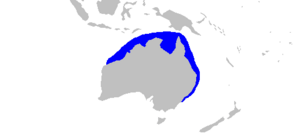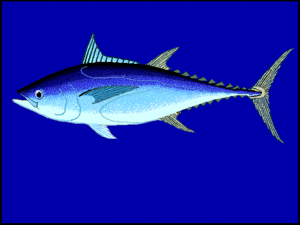Australian blacktip shark facts for kids
Quick facts for kids Australian blacktip shark |
|
|---|---|
 |
|
| Conservation status | |
| Scientific classification | |
| Genus: |
Carcharhinus
|
| Species: |
tilstoni
|
 |
|
| Range of the Australian blacktip shark | |
| Synonyms | |
|
Galeolamna pleurotaenia tilstoni Whitley, 1950 |
|
The Australian blacktip shark (Carcharhinus tilstoni) is a type of requiem shark. These sharks belong to a group known for being active and fast-swimming predators. This particular shark lives only in northern and eastern Australia. It likes to swim in the upper and middle parts of the ocean, from shallow areas near the shore down to about 50 meters (160 feet) deep.
This shark looks almost exactly like the common blacktip shark. It's so similar that scientists can usually tell them apart only by counting their vertebrae (backbones) or by looking at their genetic markers (DNA). The Australian blacktip shark usually grows to be about 1.5 to 1.8 meters (5 to 6 feet) long. It has a strong body, a bronze color, a long snout, and black tips on its fins.
Australian blacktip sharks mainly eat other fish. They often swim in large groups with other sharks of similar size and sex. These sharks give birth to live young, which means the baby sharks grow inside the mother and get food through a special connection called a placenta. They have a yearly breeding cycle. Mating happens in February and March, and females give birth to one to six pups around January of the next year. The babies grow for about 10 months inside their mother.
This shark is one of the most common sharks caught by commercial fisheries in northern Australia. Its meat is often sold as "flake". The International Union for the Conservation of Nature (IUCN) says this shark is of Least Concern. This means its population is currently healthy and not thought to be in danger from fishing.
Contents
About Its Name and Family Tree
The Australian blacktip shark was first described by an Australian scientist named Gilbert Percy Whitley in 1950. He named it Galeolamna pleurotaenia tilstoni to honor Richard Tilston, who was a doctor in Port Essington, Northern Territory. Later, scientists decided that Galeolamna was the same as the genus Carcharhinus, which is why its scientific name is now Carcharhinus tilstoni. People also sometimes call this shark the blacktip whaler or Tilston's whaler shark.
For a while, many scientists thought the Australian blacktip shark was the same species as the common blacktip shark. But in the 1980s, more studies on their bodies and life history showed they were different. Later, genetic studies confirmed that C. tilstoni is its own species. These studies also showed that the Australian blacktip shark and the common blacktip shark are closely related to other sharks like the graceful shark and the smoothtooth blacktip shark.
What Does It Look Like?
It's very hard to tell the Australian blacktip shark apart from the common blacktip shark just by looking at them. The main difference is the number of vertebrae (bones in their backbone). The Australian blacktip shark has 174–182 vertebrae in total, while the common blacktip shark has more (182–203).
This shark has a strong, torpedo-shaped body and a long, pointed snout. Its nostrils have small, triangular flaps. It has large, round eyes with special eyelids called nictitating membranes that protect them. The corners of its mouth have very small grooves. It has many rows of teeth: 32–35 rows in the upper jaw and 29–31 in the lower jaw. The upper teeth are slender and have small saw-like edges, while the lower teeth are narrower. It has five long gill slits on each side of its head.
The pectoral fins (side fins) are long and narrow, shaped like a sickle. The first dorsal fin (top fin) is also large and sickle-shaped. The second dorsal fin is not as tall and is located above the anal fin (bottom fin near the tail). There is no ridge on its back between the two dorsal fins. Just before the tail, there's a crescent-shaped dip. The tail fin is uneven, with a strong lower part and a longer upper part.
The shark's skin is covered in tiny, diamond-shaped scales called dermal denticles. These are packed closely together and overlap slightly. Each one has several ridges. The Australian blacktip shark is bronze-colored on top (but turns gray after it dies) and whitish underneath. It also has a pale stripe along its sides. Some sharks have black tips on all their fins, while others might have clear pelvic and anal fins. This shark usually grows to be 1.5 to 1.8 meters (5 to 6 feet) long. The biggest one ever recorded was 2.0 meters (6.6 feet) long and weighed 52 kilograms (115 pounds).
Where Does It Live?
The Australian blacktip shark lives on the continental shelf, which is the shallow part of the ocean floor that extends from the land. You can find it from Thevenard Island in Western Australia all the way to Sydney in New South Wales. Both the Australian blacktip shark and the common blacktip shark live in this same area. Scientists used to think there were many more common blacktip sharks, but new genetic studies show they are found in roughly equal numbers.
This shark has been seen from the very shallow areas near the shore down to about 150 meters (490 feet) deep. Bigger sharks tend to live in deeper water. Even though it can be found at all depths, it prefers to swim closer to the surface or in the middle of the water. Genetic studies suggest that all Australian blacktip sharks across northern Australia belong to one large group. Tagging studies show that these sharks usually stay in one area along the coast and don't often go far out into the open ocean. However, some have been known to travel long distances, up to 1,348 kilometers (838 miles)!
Life in the Ocean
Australian blacktip sharks often form large groups. These groups are usually made up of sharks that are similar in size and sex. They mostly eat other bony fish, like ponyfishes, grunters, tunas, and herring. Sometimes, they also eat Cephalopods like squid, especially around April. They might even eat smaller sharks. As they get older, their diet changes. Younger sharks eat more fish that live near the bottom of the ocean, while older sharks eat more fish that swim in the middle of the water and more cephalopods.
Reproduction and Life Cycle
Like other requiem sharks, the Australian blacktip shark is viviparous. This means the mother carries her babies inside her body. After the baby sharks use up the food from their yolk sac, a special connection like a placenta forms. This connection allows the mother to give food to her growing babies.
Females give birth to one to six pups each year, with three pups being the average. Mating happens in February and March. The females store the sperm until their eggs are ready in March and April. After about 10 months of gestation (pregnancy), the young are born around January of the next year.
Pregnant females move to shallow, coastal areas, like Cleveland Bay in northern Queensland, to give birth. These "nursery" areas seem to be common, as newborn sharks have been found throughout the species' range. The newborn sharks are quite large, measuring about 60 centimeters (24 inches) long. They grow quickly in their first year, adding about 17 centimeters (7 inches) to their length. Their growth slows down after that, averaging 8–10 centimeters (3–4 inches) per year by age five. Both male and female sharks become able to have babies when they are three to four years old, at lengths of about 1.1 to 1.2 meters (3.6 to 3.9 feet). Scientists believe they can live for up to 20 years.
Interestingly, scientists have found hybrid sharks that are a mix of the Australian blacktip shark and the common blacktip shark. These hybrids have been found all along the eastern coast of Australia. This is the first time scientists have confirmed that two different types of cartilaginous fish (fish with skeletons made of cartilage, like sharks) can create hybrid offspring.
Sharks and People
The Australian blacktip shark is very important for fishing in northern Australia, along with the spottail shark. In the past, a Taiwanese gillnet fishery caught these sharks for their meat and fins. This fishery started in 1974.
After Australia created its own fishing zone in 1979, the government started to limit where Taiwanese boats could fish and how much they could catch. Eventually, in 1986, Australia restricted the length of gillnets, which made it too expensive for the Taiwanese fishery to continue. By the time this fishery stopped, the number of Australian blacktip sharks was estimated to have dropped by about half. However, because this shark can reproduce fairly quickly, its population has likely grown back since then.
Since 1980, Australian commercial fishers have also targeted the Australian blacktip shark using gillnets and longlines in the Northern Shark Fishery. This shark is also sometimes caught by accident (called bycatch) by other commercial fisheries that are trying to catch bony fish or prawns. Today, the total shark catch in northern Australia is much lower than it used to be.
The meat of the Australian blacktip shark is sold in Australia as "flake". Sometimes, this meat can have high levels of mercury. The fins are sent to Asia, and other parts like the cartilage, liver oil, and skin can also be used. Because there is less fishing pressure on the Australian blacktip shark now, the International Union for the Conservation of Nature (IUCN) has listed it as Least Concern. This means they are not worried about its population right now.
See also
 In Spanish: Tiburón de puntas negras australiano para niños
In Spanish: Tiburón de puntas negras australiano para niños




